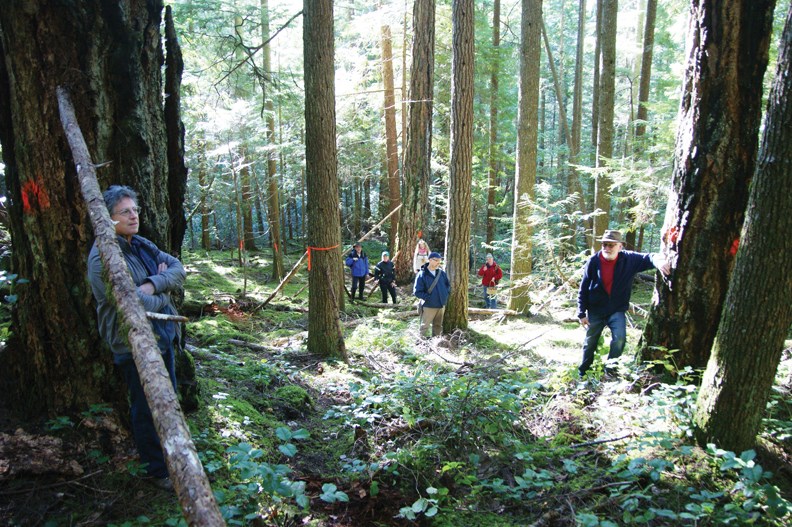The Sunshine Coast Community Forest (SCCF) is set to begin harvesting in Wilson Creek and Halfmoon Bay now that work at the site of the 2015 Old Sechelt Mine wildfire is wrapping up – and the new activity could reignite opposition to logging in the area.
In an interview with Coast Reporter this week, Community Forest chair and president Glen Bonderud and operations manager Dave Lasser talked about the recently completed harvesting of the area damaged by the fire and plans to resume harvesting other areas of its tenure.
Bonderud and Lasser said the revenue from the harvesting in the fire area was higher than anticipated thanks to a strong demand for cedar and a willingness of buyers to “come to the party.” But Lasser added that getting timber from the fire-damaged area to market has put the Community Forest’s work plan “a little bit out of sync.” Last winter’s harsher than usual weather also held up operations.
The Community Forest was expected to issue tenders Nov. 3 for the harvest of 34,500 cubic metres of timber as well as road building in three cutblocks “in permit” for harvesting between now and May of 2020.
They include EW28, the area known by some on the Coast as the Chanterelle Forest, west of Wilson Creek.
The road building could start as early as next month, with harvesting to start shortly afterwards and continue through May of 2020.
Lasser said the final decision on which of the two Wilson Creek area blocks will be harvested this season will depend on the outcome of discussions with logging contractors. Roads will be built in the other block with an eye to harvesting it in two years.
All three cutblocks have gone through the permitting process with the Ministry of Forests, Lands, Natural Resource Operations and Rural Development (FLNRO), which includes getting sign-off from the shíshálh Nation.
“The first we do after cutblocks are engineered is they go to the [Sechelt Indian] Band. The band does an archeological assessment … then we look at what we might want to put into permit at any given time, and then when we apply for a cutting permit we have to go back through the band to get the blocks cleared,” Lasser said. “Once they go through chief and council and staff, the band contacts the Ministry directly.”
“Nothing happens unless the band is part of the process,” added Bonderud.
Elphinstone Logging Focus
The Community Forest’s operations continue to face criticism and challenges from the group Elphinstone Logging Focus (ELF), especially harvesting in the Wilson Creek area. Logging in a Community Forest cutblock known as EW002 in 2012 sparked protests that led to arrests.
Speaking at the Oct. 18 meeting of Sechelt council, ELF’s Ross Muirhead urged Sechelt – which is the sole shareholder in the Community Forest’s management company, Sechelt Community Projects Inc. – to direct that no logging take place in what ELF describes as “natural, older forests.”
The Chanterelle Forest is included in that definition.
ELF wants the Community Forest to be restricted to logging areas where there has been harvesting in the past.
“It’s true that this new policy will slow down SCCF’s logging schedule and restrict timber volumes over the short term; however, [it] will enter into a new relationship with the land and community users,” Muirhead said in his submission to council.
The group has also just released a study it commissioned on Roosevelt elk in the Sunshine Coast Forest District, which it claims provides further evidence that the pace of logging should be slowed in parts of the Community Forest and BC Timber Sales (BCTS) tenure areas.
The study found signs of elk in the Wilson and Clack Creek areas. ELF’s Hans Penner said those areas have “medium to high elk winter habitat potential” and the province should be working with SCCF and BCTS to set aside areas as protected winter range.
“One of the reasons we did this study was to add further scientific evidence to justify protecting and expanding the [Mount Elphinstone] Provincial Park,” Penner told Coast Reporter.
SCCF’s Lasser acknowledged that elk are present in its tenure area, but he also said much of the tenure area is already protected through measures like Old Growth Management Areas, and a commitment not to harvest above the intakes in the Gray and Chapman Creek watersheds. Bonderud said about 20 per cent of the tenure area is under protection.
Critics have also claimed too much of SCCF’s harvest goes off-Coast or overseas and that the local economy would see greater economic benefits if the trees were left standing.
Bonderud said the bottom line is that the province requires SCCF to harvest as a condition of its tenure. “If we don’t log it, the Ministry is going to give it to someone else to log,” he said.
While some of the logs are sold locally, operations like West Coast Log Homes, Suncoast Lumber and Milling and Howe Sound Pulp and Paper have very strict requirements, so most of the logs are sold through brokers in Vancouver.
“It has to go into the Vancouver pool for sale, that’s just the way it has to be. Most of it [goes to buyers] around Georgia Strait,” Bonderud said.
Lasser estimates the number of jobs supported by SCCF activities, which he defines as people “who touch our wood and get paid for it,” ranges from 80 to more than 100 depending on the project.
To date SCCF has contributed about $1.5 million in special dividends to the District of Sechelt and $600,000 in grants to community organizations.



